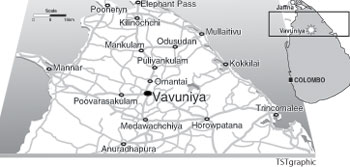Barely two weeks after their foray into Eastern Naval Area Headquarters in Trincomalee, Air Tigers showed up again.
This time they were an integral part of a pre-dawn Tiger guerrilla ground and artillery assault last Tuesday on the sprawling Security Forces Headquarters - Wanni (SFHQ - W) complex located in Vavuniya.
The defining moments of the attack on this garrison, the northernmost under Government control in mainland Sri Lanka, came thrice in regular intervals of six to seven minutes. First, a group of guerrillas infiltrated the area near the Air Force radar unit to spark off a ground battle. Then artillery and mortar shells began to rain. Thereafter, two Czech-built Zlin Z-143 aircraft appeared over the skies to drop bombs.
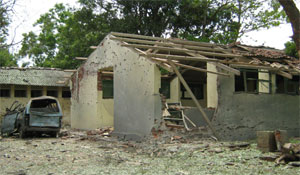 |
| One of the buildings inside the Security Forces Headquarters – Wanni (SFHQ-W) at Vavuniya damaged by last Tuesday’s Tiger guerrilla ground, artillery and air attack. |
If sparks lit up the night sky over Vavuniya, vibrations caused by the bombardment shook the doors and windows of many homes. This was in a vast area surrounding this key town, the northernmost in mainland Sri Lanka under Government control. For decades now, Vavuniya has been the gateway to the Wanni where until recently vast stretches of land were dominated by the Liberation Tigers of Tamil Eelam (LTTE). Military offensives in the past months have seen security forces regain control of large stretches, mostly west of the A-9 highway and some east of it as periodically reported in The Sunday Times (Situation Report).
Within minutes of news of the attack reaching Colombo, everyone who is someone in the country's defence and security establishment was out of their beds. Whilst officials clasped their phones to receive updates, security forces top brass were busy with their respective operations rooms. Minute-by-minute feedbacks were reaching Colombo as the mayhem continued for some five and half hours.
Last Tuesday, it all began minutes before 3 a.m. Some 14 guerrillas infiltrated the Army sector by traversing through private property. This is at a relatively thin stretch, soon after the main entrance, before the complex expands to a much larger ground area. They wore fatigues resembling the Army. They were walking past buildings occupied by two different battalions of the Army's crack Special Forces. It is here that the gun battles broke out. Alert Special Force personnel began engaging the guerrillas. Three female cadres blasted themselves using the 'suicide kits' they wore. Another committed suicide by biting a cyanide phial. Others edged forward to fire their assault rifles and Rocket Propelled Grenade (RPG) at the Indira II radar installed on a knoll or a small hill.
The radar was damaged and two Indian maintenance technicians - A.K. Thakur and Chinthamani Rant - sustained injuries. They were later driven to Anurahdapura and airlifted to Colombo. Another Indira II to replace the radar that was damaged was hurriedly moved by the Air Force on the same day from their main base at Katunayake. The aim of the guerrillas was to destroy the Vavuniya air defence radar, the one that was usually the first to locate any guerrilla aircraft that is airborne from the Wanni. By moving a replacement Tuesday evening, the Air Force denied the guerrillas any freedom of movement over the air in the Wanni theatre without being detected.
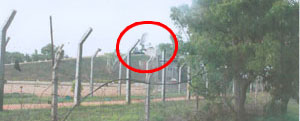 |
| The Indira II (2D) radar at the Air Force sector inside Security Forces Headquarters – Wanni in Vavuniya. |
Four Indira II radars (named after late Indian Prime Minister, Indira Gandhi) were gifted to Sri Lanka. This was after it became known that the LTTE had acquired air capability by procuring Zlin Z-143 light aircraft in 2005. Radars are used to detect aircraft, vehicles, ships or other objects through the transmission of electromagnetic waves, which are reflected back by the object. A 2-D radar gives distance and direction whilst 3-D radar would also provide the (height) or altitude in the case of aircraft.
The Air Force area that was under attack lay near the Army's 211 Brigade. Also located in the same vicinity are the second and third battalions of the Special Forces. There is no doubt the guerrillas would have carried out months and months of surveillance piecing together all the information about this target they were to attack. They would have also practised with sand models to prepare their cadres before launching last Tuesday's attack.
This was much the same as the land and air attack on the Air Force base in Anuradhapura on October 22, last year. However, it appears that the guerrillas may have either not known or failed to take into consideration the presence of the Special Forces (SF) troops in the area they infiltrated. The measures the SF adopted to protect their troops and installations evidently took the attackers by complete surprise. Besides those who committed suicide, SF troops shot dead within a short time the majority of the guerrillas who had infiltrated and planned to wreak further havoc.
Within six to seven minutes of the ground attack, heavy artillery and mortars began to fall in the same area. Highly placed security sources said the guerrillas had shifted two 130 mm artillery guns to an area closer to Puliyankulam, located a few kilometres away from the guerrilla checkpoint at Omanthai. Mortars had been fired from locations nearby. These guns had been used earlier from the general area of Pooneryn to periodically direct artillery fire at the Security Forces Headquarters in Jaffna. There were occasions when such attacks forced the Air Force to call off temporarily all military and civilian flights to Palaly.
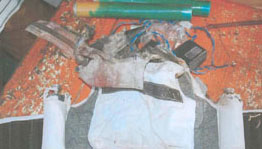 |
| A guerrilla suicide kit located at the scene of attack by the Army. |
Police later learnt that a guerrilla atop a tree and carrying a walkie-talkie gave directions to their artillery gunners to fine tune their targets in the area. Some had artillery shells which missed the mark and fell outside the complex near houses. At least two civilians and a child were injured at Teak Gardens (Thekka Watte). They were treated at the Vanuniya hospital. One such barrage had killed six cows and bulls. The same sources said the Army directed counter artillery fire destroying one guerrilla artillery gun. However, independent verification of this claim is not possible.
The guerrillas had fired some 70 to 80 heavy artillery rounds during the pre-dawn attack. Later, on Tuesday afternoon two more rounds fell on the military complex. This was when troops were on a clearing operation within the area as well as ahead of their defended localities.
Another six to seven minutes later, two Air Tiger Zlin Z-143 aircraft were over the military complex. First reports said they dropped eight bombs - four near the Air Force installations on the relatively narrow stretch of land just after the main entrance. The other four had been dropped on the large area that encompasses many buildings including administrative blocks of the SFHQ-W. Three had not exploded. Investigations thereafter have raised doubts on the number that exploded, whether it was only three or less and whether only five or six bombs were dropped.
This is after a close examination of the sites that have been badly damaged. Investigations are continuing.
The ground, artillery and air attack had begun just before 3 a.m. Tuesday. Within an hour it had ended. However, the search operations for more possible guerrilla infiltrators continued until 7.30 a.m. It is only thereafter that the damage caused and the casualty counts became clear.
Roofs of buildings near the Air Force installations were badly damaged. In the Police sector at SFHQ-W, there was a sigh of relief. The roof of the main armoury of the division was badly damaged but a concrete slab below had protected the weaponry from being destroyed. Six vehicles including a bowser, truck, van and a tractor were damaged.
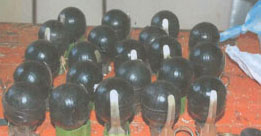 |
| Grenades found by the Army after the attack. |
Initial reports to the media by Army officials said bodies of ten Tiger cadres, including five females, were found within the military complex. As this news spread worldwide, the LTTE repeated the same figure in a news release. Their idea was to hide the exact number of cadres who were assigned to carry out the attack. Later on Tuesday, another male guerrilla body was found bringing the LTTE death toll to 11. Preliminary investigations by the Police have revealed that 14 guerrillas entered the military complex and three later got away. They left behind assault rifles, RPGs, grenades, communication sets, a machine gun, a global positioning system, ammunition, chocolates among other items.
The 14 guerrillas who took part in the attack Police believe is in addition the one who was atop a tree serving as a forward observer to direct artillery fire. This is not the first time the LTTE had juggled with numbers and doctored photographs to give the impression that all their cadres assigned for attacks had been killed.
They did so during the attack on the Air Force base in Anuradhapura. Last Tuesday's attack is no exception. See box story on page 5.
Thirteen soldiers, a civilian attached to the Army and a policeman were killed at the scene. Another police officer died at the Vavuniya hospital bringing the death toll to 16. Those wounded were: Army 24, Air Force 7 and Police 9.
The Sri Lanka Air Force claimed later on Tuesday that one of its Chinese built F-7 interceptor jets had destroyed one of the Air Tiger aircraft. Two officers of the Air Force, a security source said, were on hand at last Wednesday's National Security Council meeting to provide a brief on how the attack occurred.
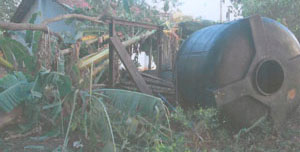 |
| Part of the damage caused to the Police section at the SFHQ-W |
Though the Air Force has no pictorial evidence either of the attack or the debris of the destroyed aircraft on the ground, an Air Force source told The Sunday Times "the pilot activated the firing mechanism only after his on board radar locked on the target. That was how the air-to-air missile was discharged. Thereafter, when he was taking a turn, he saw a huge ball of fire some 600 metres away." The source claimed the missile would not have been released automatically if the lock-in mechanism did not home in on the target. However, the LTTE said its aircraft had "returned safely." Independent verification of both claims is not possible.
In a statement issued on Tuesday, the LTTE said:
"A Black Tiger unit of the Liberation Tigers of Tamil Eelam launched a pre-dawn attack on the radar station situated in the Wanni Operational Headquarters of the Sri Lankan armed forces at 035 hrs, 9th September, 2008. The radar station was destroyed in the attack. The Air Tigers and a battery of Col. Kiddu Artillery Regiment assisted the Black Tigers team in this attack. At least 20 Sri Lankan soldiers were killed and several wounded in the attack.
"The aircraft of the Air Tigers that participated in the sortie safely returned home. "Weaponry stores, communication tower, communication facility and anti aircraft guns were also destroyed in this attack. Regional commanding stations of the Wanni Command and the Special Forces of the Sri Lankan Army were badly damaged in this attack. Ten Black Tigers have sacrificed their precious lives for the liberation of our Motherland in this attack."
The salutary feature of last Tuesday's attack is the role played by troops of the Army's Special Forces. They did minimise the damage that would have been caused to the Air Force radar station. However, the incident has once again highlighted the woefully inadequate measures to ensure perimeter security in military installations.
Like during the attack on the Air Force base at Anuradhapura, the guerrillas succeeded in infiltrating a major headquarters complex. With that, directing artillery fire and using aircraft primitive compared to the assets of the Air Force, they succeeded in creating an impact as they came under heavy pressure on the battlefronts in the Wanni.
Figures,
photos
doctored?
An attempt once again by the LTTE to make it appear that only ten of their cadres, five males and five females, took part in last Tuesday's ground assault on the Security Forces Headquarters in Wanni (SFHQ-W) proved futile.
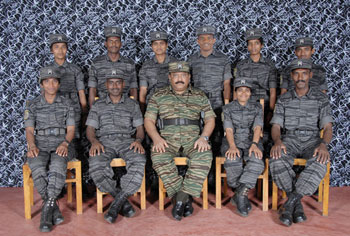 |
| The LTTE picture posted on the Tamilnet shows LTTE leader, Velupillai Prabhakaran with the ten cadres who were purportedly involved in the attack. Police said at least 14 cadres took part. |
The figure of ten guerrilla deaths was the first official account given by the military. It said five male and five female bodies were found within the Wanni military complex.
By Tuesday afternoon, the Tamilnet website released a photograph of the ten cadres posing with their leader, Velupillai Prabhakaran before they died during the attack. The picture, The Sunday Times learnt, has been doctored to show only ten. Later on Tuesday, one more dead body of a guerrilla cadre was found within the military complex. This is besides at least four others who escaped.
A senior Army official at Vavuniya said that 14 bodies of guerrilla cadres were handed over to the LTTE through the International Committee of the Red Cross (ICRC) last Thursday. He said 11 bodies belonged to guerrillas who were killed when they attacked the SFHQ (Wanni). Three others were killed in encounters with the Army in the Weli Oya sector.
However, Aleksandra Matjevic, ICRC spokesperson told The Sunday Times she could not say how many bodies belonged to LTTE members who were involved in the attack in Vavuniya. She said she could only confirm 14 bodies were handed over on Thursday.
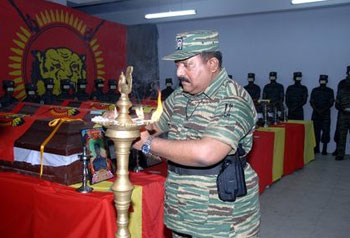 |
| LTTE leader Prabhakaran “honouring” the Black Tiger cadres during ceremonies before their funeral. - tamilnet. |
On Friday, Tamilnet posted a picture of LTTE leader, Velupillai Prabhakaran "honouring" the "ten dead Black Tiger cadres." It showed only a few coffins.
Soon after the attack on the Air Force base in Anuradhapura in October, last year, the LTTE said in a press release that 21 of its "Black Tigers" had died. However, CID investigations revealed that 27 had taken part in the attack. On that occasion too, the Tamilnet website posted a picture of Mr. Prabhakaran posing with only 21 Black Tigers.
But, months later Tamil websites posted reports and photographs of Mr. Prabhakaran “honouring” cadres who had taken part in the attack on the Anuradhapura air base. This included those who had survived.
|






